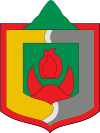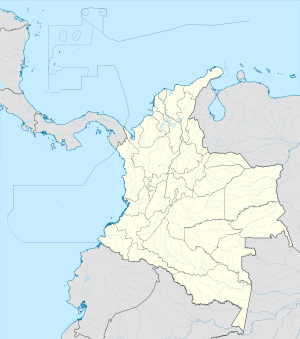Riosucio, Caldas facts for kids
Quick facts for kids
Riosucio, Caldas
|
|||
|---|---|---|---|
|
Municipality and town
|
|||
|
|||

Location of the municipality and town of Riosucio in the department of Caldas
|
|||
| Country | |||
| Department | |||
| Founded | August 7, 1819 | ||
| Founded by | José Bonifacio Bonafont & José Ramón Bueno | ||
| Area | |||
| • Total | 429.1 km2 (165.7 sq mi) | ||
| Elevation | 1,783 m (5,850 ft) | ||
| Population
(2009)
|
|||
| • Total | 57,220 | ||
| Time zone | UTC-5 (Colombia Standard Time) | ||
Riosucio is a town and municipality in the department of Caldas in Colombia. It is famous for its amazing carnival, officially called the Carnival of Riosucio. Many people still call it the "Carnival of the Devil." This carnival is one of the biggest and most popular festivals in Colombia!
Riosucio is located in the Colombian coffee growing axis. This area is known for its beautiful coffee farms. In 2011, the municipality became part of the "Coffee Cultural Landscape." This is a special UNESCO World Heritage Site.
Contents
- Where is Riosucio?
- What is the Climate Like?
- The Famous Carnival of Riosucio
- See also
Where is Riosucio?
Riosucio is in the western part of the Caldas department. It shares borders with other towns and departments. The total area of the municipality is about 429 square kilometers.
The town of Riosucio is high up, at 1783 meters above sea level. It is about 91 kilometers west of Manizales. Manizales is the capital city of the Caldas department.
What is the Climate Like?
The weather in Riosucio is nice all year round. The average temperature is about 20 degrees Celsius (68 degrees Fahrenheit). This makes it a pleasant place to visit!
The Famous Carnival of Riosucio
The most exciting thing about Riosucio is its Carnival of Riosucio. It is also known as the Carnival of the Devil. This huge party happens every two years in early January. It takes place in odd-numbered years.
It is one of Colombia's most popular carnivals. Other famous carnivals are in Barranquilla, Manizales, and Pasto. Riosucio is a small town, but it welcomes thousands of visitors. Because of this, finding a place to stay can be tricky. Hotels often get booked months ahead of time. Some visitors even bring tents or sleep outdoors!
Who Participates in the Carnival?
The main groups in the parades are called cuadrillas. These are teams of people, often family members or relatives. They dress up in costumes and parade through the streets. This happens on several days of the carnival.
Where Does the Fun Happen?
The whole town is full of activities and parties. But the main spots are the plazas outside the two main churches.
- San Sebastián is the red brick church in the upper part of town.
- La Señora de la Candelaria is the cream and yellow church in the lower part of town.
These two churches are only one block apart! All parades end at one of these plazas. Stages are set up in each plaza. The cuadrillas perform there. There is also live music and traditional dances. This goes on during the day and evening of the festival.
What Kind of Music is Played?
You will usually hear salsa bands. You might also hear chirimías. These bands are named after a woodwind instrument. It is like an old-fashioned oboe. They also play guitars and drums.
Daily Carnival Schedule
Most days of the festival start early and end late. A music band parades around town at 5 AM. They play alboradas, which are wake-up songs. Every night, verbenas (parties with music for dancing) entertain everyone. They go on late into the night. Officially, events end at midnight. But often, parties continue in the streets all night long!
What is Guarapo?
The traditional drink of the carnival is guarapo. It is a fermented sugar cane liquor. People traditionally drink it from a gourd. This gourd is also an important symbol of the carnival.
The Devil, She-Devil, and Gourd
A large model of the Devil is the main symbol of the carnival. There are also two other models: a She-Devil and a Gourd. During the carnival, the Devil and She-Devil are kept apart. The Devil stays in one church square. The She-Devil stays in the other.
In 2006, the Colombian government declared the carnival an Event of Cultural Interest. This means it is very important to the country's culture.
How the Carnival Started
The carnival has an interesting history. In the 17th to 19th centuries, two groups lived near Ingrumá Mountain. They were rivals.
- One group was from Quiebralomo. They were Spanish descendants and had African slaves.
- The other group was the indigenous people of La Montaña.
These groups fought over land and mining rights.
In 1814, two priests tried to bring them together. They were Doctor José Bonifacio Bonafont and José Ramón Bueno. After years of effort, the groups agreed to share their land. The town of Riosucio was created on August 7, 1819. This is the town's founding date.
Riosucio has a unique layout. Its two main churches are just one block apart. This shows how the two rival groups became one.
Originally, a statue of Jesus was placed between the churches. It marked the boundary between the two parishes. But people still crossed the line. So, a statue of the Devil replaced it. This was meant to make people afraid to cross. Even after unification, there was still some tension.
In 1847, a carnival of unification took place. The Devil became the symbol of this unity. The carnival happened on January 6. This day celebrates the Feast of the Three Kings (Epiphany). The first regular carnival was in 1912. The Devil became the official "mascot" in 1915.
Carnival Timetable: What Happens When?
The main festivities are in January. But the carnival officially starts in July of the previous year. That's when the "Republic of Riosucio" is declared. A "president" is chosen. A "decree" is read out. It usually makes fun of the people of Riosucio in a gentle way.
The exact dates of the carnival change each year. But it always lasts for six days. It runs from a Friday to the following Wednesday. These days always include January 6. This is the anniversary of the first festival.
Friday (Day 1) – Children's Carnival
- Alegre despertar (Joyful Awakening): This procession happens at midnight. It marks the official start of the carnival.
- Children's procession: The children's cuadrillas parade. Then they perform on stage. There are also fun activities for kids.
Saturday (Day 2)
- Gran Entrada de Colonias (Grand Entry of the Colonies): This parade welcomes people from Riosucio who now live elsewhere. It is a way to show them they are still welcome.
- Entrada Triunfal de su Majestad el Diablo (Triumphal Entry of His Majesty the Devil): This is an evening parade.
Sunday (Day 3) – Magnificent Day of the Adult Teams
- Grandioso Desfile de Cuadrillas de Mayores: This is the most important day! It starts with the adult cuadrillas parade in the morning.
- Performances: In the early afternoon, each cuadrilla performs two songs. They perform on stages outside the two churches. The music is usually a well-known Latin or pop song. But the words must be completely new. They are written by the cuadrilla members. The songs can be about the carnival or social issues.
- Home visits: Each cuadrilla also performs at private homes. This is for people who cannot go out, like the elderly. Because there are many cuadrillas, performances can go on late into the night.
Monday (Day 4) – Day of Riosucenian Brotherhood
- Procession of Riosucenian Brotherhood.
- First day of corralejas: This event takes place in the town's bullring. It is like a mix of a rodeo and bullfighting. But in Riosucio, the bulls are not harmed.
- Procession of Candles.
- Noches del Ingrumá: A night-time firework show.
Tuesday (Day 5) – Day of Individual Costumes
- Second day of corralejas.
Wednesday (Day 6) – Last Day
- Procession of the Gourd.
- Final day of corralejas.
- Closing ceremony: At midnight, the Gourd is buried. A model of the Devil is burned. This marks the official end of the festival. The Devil that is burned is not the main one. It is a papier-mâché copy made just for that year.
See also
 In Spanish: Riosucio (Caldas) para niños
In Spanish: Riosucio (Caldas) para niños




